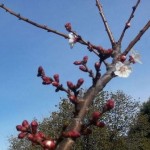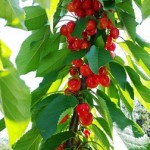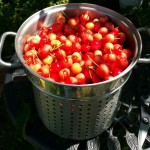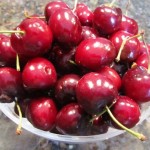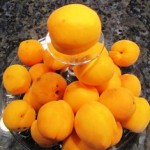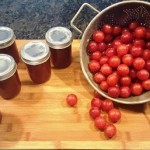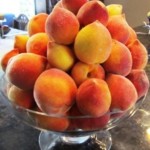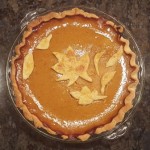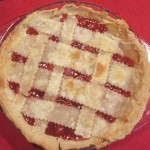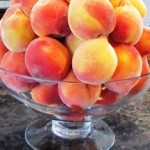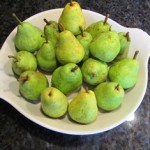Growing a Bountiful Crop of Sweet Cherries
Cherries are perfectly suited for growing well in our northern California climate. About ten years ago, we planted several sweet cherry trees–Bing, Stella, and Black Tartarian. They’ve proven to be easy trees to grow and reward us with bountiful crops of sweet, ripe cherries around Memorial Day each year.
If you want to grow some sweet cherries, you’ll need to space for a tree or two. Sour cherries will self pollinate but sweet cherries need a pollinator and that means you’ll need to plant two trees 30 to 40 feet apart unless you are growing a dwarf variety. Dwarf trees should be spaced 5 to 10 feet apart. The trees need sun, good air circulation, and well-drained fertile soil. Drainage is important because cherry trees are susceptible to root rot.
Once the trees are established, prune in early spring to remove large limbs or those that are broken, damaged, or too weak to produce fruit. In late summer, a second pruning can be done (this one less aggressive) to open up the canopy and improve air circulation.
A newly planted cherry tree can take three to five years to produce fruit. But you’ll be rewarded when your full-size tree produces 40 to 50 quarts of ripe fruit. In Northern California, cherries ripen from early June to late July.
You’ll be sharing your ripe cherries with the birds unless you use netting over your tree. A bird will peck a single hole in a perfect cherry and then move on, leaving the damaged cherry to rot on the tree. Local wildlife such as opossums and raccoons also enjoy feasting on cherries, climbing the trees to reach the fruit.
Cherries must be picked at the peak of perfection for if they are picked too soon, the fruit will not slowly ripen in your kitchen. Cherries are more perishable than blueberries, so wash and eat them soon after picking. A pit remover makes it easy to remove the stone from the center of the fruit.
Some people prefer sour cherries for making pies and jam and sweet cherries for eating fresh. Preserve cherries after removing the pits by canning in a hot water canner, drying them using a dehydrator, or freezing them.
______________________________________________________________________________
If you enjoy reading about our adventures in country living, check out my Henny Penny Farmette series of cozy mysteries. They’re chocked full of delicious recipes, gardening tips, and insights into keeping chickens and honeybees. Or, learn about how to take better care of yourself with my health, wellness, and spirituality books. All are available online and wherever books are sold.
Late to Ripen But Oh, So Yummy!
Following the historic long seasonal deluge of rain, our fruit trees are loaded with peaches, apricots, plums (the cherries are gone now). While there is plenty of stone fruit, it’s all ripening late this year.
Our Blenheim apricots were ready to pick, dry, and make into jam in late May of 2018. On this last day in June, I plucked an apricot that was ripe on the side facing the sun but the opposite side was green and hard.
The cherries, too, ripened late this year. We picked about 8 gallons of cherries from our two Bing and Stella trees. I dried some and we gave away a lot.
The Black Tartarian cherries didn’t produce as heavily this year as last. By the time we discovered the ripe cherries, the birds had already beaten us to the super-sweet fruit. I don’t mind sharing with the local wildlife, but would have loved a bowl of these for snacking.
The yellow and red plums are finally ripe now. Today, I’m making plum jam. Nothing beats hot toast with spreadable summer jams and marmalade for breakfast on a winter’s day. In a normal year, most of my jam-making of stone fruits would be finished by now.
The early Desert Gold peaches are gone now, a tasty memory, from a month ago. However, we still have summer peaches clinging to the tree. I check them daily. Fresh peach pie for the fourth of July is a favorite at my house.
While the fruits and berries seem to ripen more slowly this year, my vegetable garden is blowing my mind. I have several raised beds in a fenced-off area so wild animals won’t bother it. Most of the raised beds were used for composting (think, tons of chicken manure, yard clippings, and cardboard). Still, I added other organic amendments. Boy, is that soil paying off.
It’s a banner year for vegetables on the farmette. Most will be eaten fresh but the sugar pumpkins won’t ripen until autumn. Love them in pie.
_____________________________________________________________________________________
I’ve been told I’m living a “charmed life” on my Henny Penny Farmette. And so it is. But this chapter of my life didn’t happen by accident. I once lived in Silicon Valley and was part of life in the fast lane, which I enjoyed. But I grew up on a farm. I missed time in nature, eating foods that I knew were healthy and wholesome and pesticide-free, and the slower pace of life. I set an intention to manifest the life I have now. You can, too.
FIND ME ALSO at Meera-lester.com (don’t forget that hyphen…very important.)
If you enjoy reading about gardening, keeping chicken and bees, and other farm topics, pick up copies of my Henny Penny Farmette series of cozy mysteries. The books are chocked full of farm and craft trivia as well as delicious recipes and, of course, intriguing mysteries.
Swimming in Fruit
Our cherry trees became so heavily laden with fruit this year I couldn’t work fast enough to make the fruit into cookies and pies and jars of jam, conserve, and chutney.
What fruit the birds and squirrels didn’t devour ended up drying on the trees and looking like ornaments. I’m heartened that at least the wildlife will have something to forage on through fall and winter.
The apricot trees did a massive drop of their fruit and seemingly all at once. I made more jam than we’ll probably eat, dried some, and gave away more than a few full buckets of cots to neighbors and friends. I also had to do a messy cleanup of fruit on the ground.
In the cycle now are the summer peaches; so, here I go again . . swimming in fruit.
Next year, I’m going to get my act together early with teams of backyard pickers who can help me remove the fruit, divide it, and distribute it. Right now, however, I’ve got peaches to pick and preserve. The summer pears and figs will be next.
I’m not complaining; I’m enthralled that all this bounty is due to the work of our industrious little honeybees. All this fruit and I haven’t even mentioned finding time to harvest honey. Yet, the bees don’t stop, so neither will I.
________________________________________________________________
If you enjoy reading about farmette topics like keeping bees and chickens, caring for an orchard, or growing heirloom herbs and vegetables, check out my mystery series from Kensington Publishing (due out September 26, 2017).
These novels feature a whodunnit for you to solve and are filled with farming facts, trivia, and delicious recipes. The novels and my other books are available in traditional and online bookstores everywhere. See, http://tinyurl.com/yb42zd2d
Celebrating the Fourth–Hankering For Nostalgia
On the farm where I grew up in central Missouri, we celebrated the Fourth of July with a fish fry. We caught blue gill, bass, crappie, and catfish in my grandfather’s stocked ponds or from nearby Perche Creek.
After my brother, cousins, and I played games until dark and then chased fireflies, my grandmother would set out dessert–a simple blackberry pie, shortcake and berries with homemade ice cream, or a pineapple upside down cake. A grownup would surprise us kids with sparklers that we would light and wave as we ran around in the dark.
Feeling nostalgic for those old days and ways of celebrating, I’m going to shuck and cook corn on the cob and grill some salmon with fresh veggies from the garden for this–our eighth celebration of this holiday on the farmette. There’s a ton of summer squash that I’ll douse with olive oil and sprinkle with seasoning before grilling.
For the salmon, I make a easy-peasy mango-lime-cilantro salsa. Chop red onion and red and green bell pepper. Cube slices of fresh mango. Take a handful of cilantro that’s been tightly rolled and chop it into ribbons. Mix everything together, sprinkle with sugar, and generously drizzled with fresh lime juice. Serve well chilled over the grilled salmon.
I’ve already whipped up a pineapple upside down cake and baked it in my 10-inch cast iron skillet. To save time, I used a yellow cake mix and added a dash of rum and pineapple juice for flavor. Recipe is below.
QUICK PINEAPPLE UPSIDE DOWN CAKE
Ingredients:
1/2 cup plus 2 Tablespoons butter
1 1/4 cups sugar
7-8 slices of canned pineapple
7-8 maraschino cherries
1 box yellow cake mix
1 Tablespoon dark rum
1/8 cup pineapple juice
Directions:
Preheat oven to 350 degrees Fahrenheit
In a cast iron skillet over medium heat, melt the butter. Add the sugar and stir until the sugar turns light brown (roughly 5 to 7 minutes). Remove from heat. Carefully lay in the pineapple slices. Place a cherry in the center of each fruit ring.
Make the cake according to directions on the box. Add the rum to the batter. Pour over the pineapple slices in the skillet.
Place the skillet on the middle rack in the oven and bake the cake at 350 for 30-40 minutes. Guard against over browning of the top. If necessary, lay a layer of aluminum foil over the cake near the end of the bake time. Use a knife around the cake edges to loosen from the skillet. Turn upside down onto a cake plate. Enjoy.
_______________________________________________________________
If you’re interested in farmette topics and storytelling, check out my Henny Penny Farmette series of mysteries. All three books in the series are available in numerous formats and can be ordered from Amazon, Barnes and Noble, and elsewhere online as well as from traditional bookstores everywhere.
These cozy mysteries make great summer reading and they include delicious recipes, tips for keeping bees and chickens, and facts and tidbits about growing heirloom vegetables and herbs.
Please see more at http://tinyurl.com/ya5vhhpm
Busy Bees and Abundant Rain Spell Bumper Crops in the Orchard
Thanks to the drought-ending rain and the robust activity of our honeybees, my orchard has produced a phenomenal crop of cherries, apricots, and plums this year.
I picked some wild plums today. They’re unusually sweet so I will make them into jam this week. I think the apricots will be ready next week. Today, I’m getting ready for jam-making by taking down cases of canning jars from the storage shelf over the washer and dryer. I’ll need to get lemons, bags of sugar, pectin, and jar lids.
The vegetable garden is also benefiting from bee activity. The summer Italian striped squash and the crooked neck squash plants are producing squash faster than we can eat them. The tomato vines are loaded, and I expect the corn to be ready soon, too.
Nothing beats fresh summer jams to brighten a dreary winter morning. This summer, I hope to make enough to last through 2017 winter into next spring. This past winter, I ran out of apricot jam because it is the one most of our neighbors, family, and friends prefer. But thanks to the rain and the bee activity, running out of jam won’t be a problem for next year.
____________________________________________________
Like my honeybees, I’ve been busy this winter/spring, writing two nonfiction books for readers who embrace the path of yoga, healthy living, meditation, meaningful ritual, and mindfulness. To be released this year: My POCKET MEDITATIONS (July 2017) and MY DAILY RITUALS (Christmas 2017).
Check out MY POCKET MEDITATIONS, the newest forthcoming nonfiction title from Adams Media/Simon & Schuster, at http://tinyurl.com/l6lzorq
![My Pocket Meditations: Anytime Exercises for Peace, Clarity, and Focus by [Lester, Meera]](https://images-na.ssl-images-amazon.com/images/I/51GH%2BXEPc6L.jpg)
COMING SOON: My newest offering in the Henny Penny Farmette mystery series, A HIVE OF HOMICIDES (Kensington Publishing, Sept. 2017).
Drying Fruits Naturally
I love dried apricots, but don’t tolerate well the ones treated with sulfur dioxide(used to prevent oxidation and loss of color). With so many apricots on our property coming ripe at once, I have decided in addition to making jam this year to also dry some of the fruit.
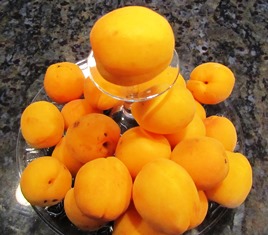
Apricots, so plentiful this time of year, are easy to dry and make great snacks when the season is over
Apricots dried but not treated with sulfur dioxide will turn a natural brown color. Some stores sell them this way. They are usually priced the same or similar to the treated apricots with the bright orange hue.
Besides apricots, other fruits that dry well include apples, bananas, cherries, grapes, nectarines, peaches, pears, plum, rhubarb, and even strawberries. You can use a drying machine
Quick Tips for Drying Fruit
1. Choose to dry only the freshest picked fruits, without bruises, scale, sun scald, or other blight.
2. Spray nonstick vegetable spray on drying pans or trays to make it easier to remove the dried fruit
3. Lay out the fruit to dry in a single layer on trays. Remember to rotate the trays occasionally and turn the pieces from time to time.
4. Destroy any insects (miniscule or otherwise) by freezing or baking the fruit. Simply take the tray and stick it into an oven heated to 175 degrees Fahrenheit for about 15 minutes. Alternatively, pack the dried fruit in freezer bags and freeze for at least 2 days.
5. Freezing dried fruit in resealable freezer bags will preserve its shelf life.
 Facebook
Facebook Goodreads
Goodreads LinkedIn
LinkedIn Meera Lester
Meera Lester Twitter
Twitter



